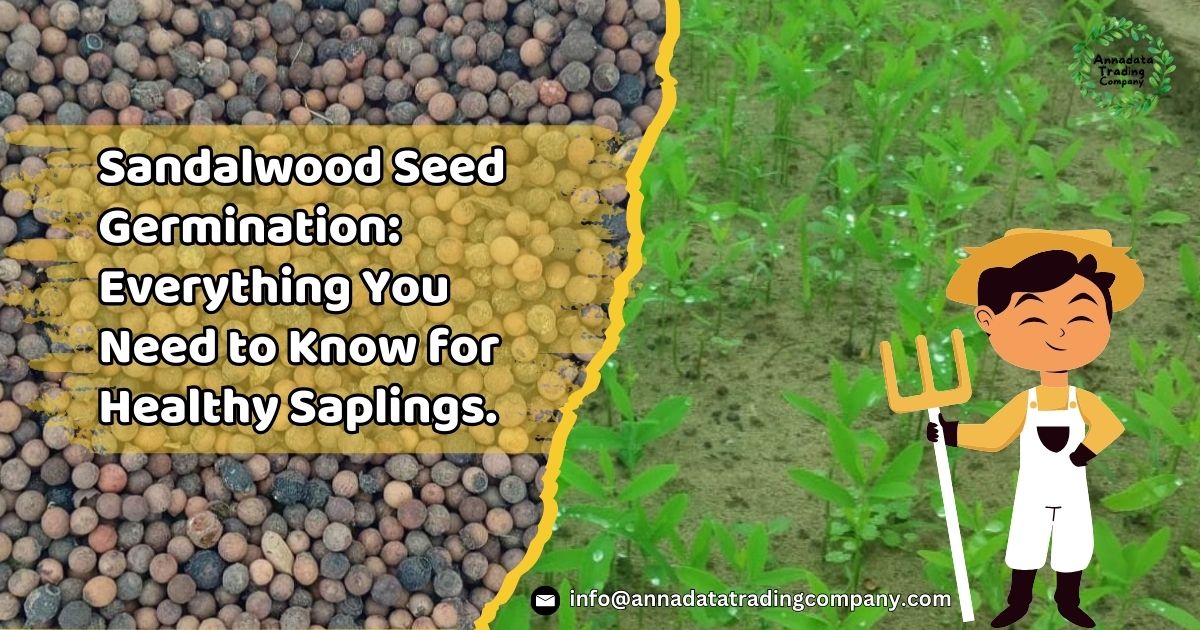Sandalwood Seed Germination: Everything You Need to Know for Healthy Saplings.
Sandalwood (Santalum album) is a precious tree valued for its fragrant heartwood and essential oils. Growing sandalwood from seed is a rewarding but delicate process requiring attention to seed preparation, soil conditions, and care during germination. So let us know in this blog Sandalwood Seed Germination.

Table of Contents
Sandalwood Seeds Varieties.
1) Santalum album (Indian Sandalwood or White Sandalwood.
Native to India, Indonesia, and parts of Australia.
Most valued for its fragrant heartwood and high-quality sandalwood oil.
Grows as an evergreen, hemiparasitic tree, often cultivated in India’s dry tropical regions, especially Karnataka, Tamil Nadu, Maharashtra, and Andhra Pradesh.
2) Red Sandalwood (Pterocarpus santalinus)
- Valued for its red-colored timber and used for ornamental and medicinal purposes, mainly found in India.
Click on the button below for plants or seeds.
Step-by-Step Sandalwood Seed Germination Guide.
1. Seed Preparation
- Sandalwood seeds have a hard shell; soaking them in a natural cow dung slurry for 12 hours improves germination success.
- Alternatively, soak seeds in gibberellic acid solution mixed with sodium hydroxide to speed Germination (especially for commercial planting).
- Lightly nicking the seed coat with a blade can help water absorption.
2. Soil and Bed Preparation
- Use well-drained sandy soil or a mix of sand and fertile soil (1:1 ratio).
- Raised or sunken seed beds (about 10m x 1m) are ideal.
- Maintain good moisture and high humidity but avoid waterlogging.
3. Sowing Seeds
- Plant seeds 1.5 cm deep in prepared beds or pots.
- Cover seeds lightly with soil or sand.
- Water gently, using a fine mist spray to keep soil moist.
- Keep the sowing area shaded from direct sunlight.
4. Germination Conditions
- Seeds typically germinate within 21 to 60 days.
- Maintain temperatures between 25–40°C with high humidity.
- Cover seed beds partially with straw or fiber bags to retain moisture.
- Mist regularly.
5. Early Growth and Care
- Sandalwood is a hemi-root parasite requiring host plants like red gram, drumstick, or pigeon pea nearby.
- After 2 months, seedlings become strong enough for transplanting into polybags with nutrient soil.
- Harden the seedlings by gradually exposing them to sunlight before field planting.
High Quality Sandalwood Seeds Available 🎋
— Annadata Trading Company (@ATCSEEDS) September 9, 2025
✅ High Germination Rate.
✅ Best for Farming.
✅ Fast Growth & Strong Plants.
✅ Suitable for All Soil Type
🧑💻Order Now: 👇
🏢 Annadata Trading Company
☎️ 092844 02685 #sandalwoodseed #sandalwood #sandalwoodfarming #seeds pic.twitter.com/QX810ZYBGI
Sandalwood Seed Germination: Common Challenges & Tips
Germination rates vary; with good care, 60-80% germination is achievable.
Protect seedlings from pests and fungal infections by spraying fungicides if necessary.
Host plant availability is crucial for proper sandalwood growth.
Conclusion
Growing sandalwood from seeds is a sustainable investment toward ecological and economic benefits. Following proper seed preparation, soil care, and nurturing will ensure healthy sandalwood saplings ready for plantation.
FAQs
1) How many years does it take to grow sandalwood trees?
Usually 15 to 20 years to get mature sandalwood wood.
2) Is it legal to grow and sell sandalwood?
Yes, but permits and government regulations must be followed.
3) What type of soil is best for sandalwood cultivation?
Well-drained red soil is best; black cotton and clay soils are unsuitable.
4) How many trees can be planted per acre?
About 500 seedlings spaced 10’x10’ per acre.
5) What are the host plants for sandalwood?
Nitrogen-fixing plants like casuarina, tamarind, Amla, Malabar neem, Mahogany are suitable hosts.
6) What is sandalwood growth rate?
Sandalwood grows slowly, about 1 to 1.5 feet per year reaching full maturity around 15 years.
7) What is the estimated sandalwood yield?
15 to 20 kg of heartwood per tree after 15 years, increasing if grown longer.
8) Are there government subsidies or assistance for sandalwood farming?
Various state programs offer subsidies and support for sandalwood growers.
9) How to protect sandalwood from theft and pests?
Use fencing, security guards, and regular monitoring.
